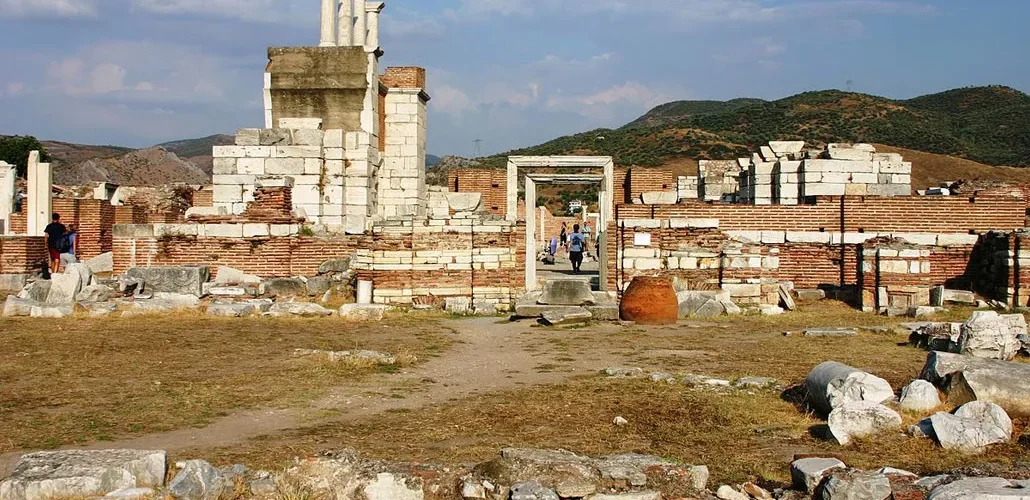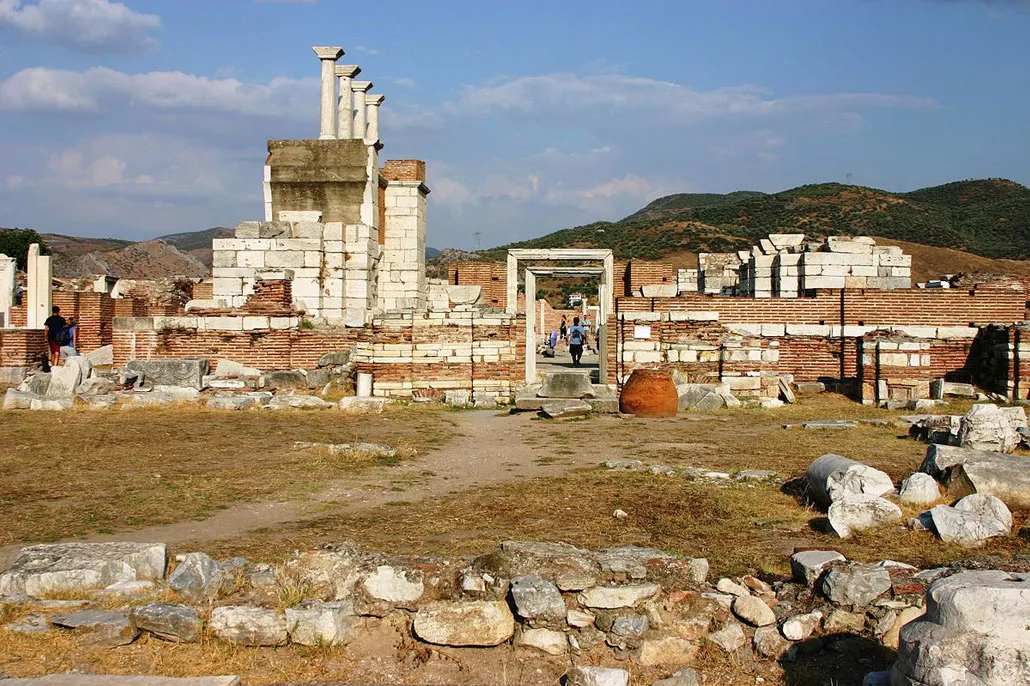
Introduction
The Basilica of St. John (Greek: Βασιλική του Αγίου Ιωάννη του Θεολόγου) was a basilica in Ephesus. It was constructed by Justinian I in the 6th century at a site where John the Apostle was said to have been buried. It was modeled after the now-demolished Church of the Holy Apostles in Constantinople. The basilica is on the slopes of Ayasuluk Hill, right next to the İsa Bey Mosque, just below the fortress near the centre of Selçuk, İzmir Province, Turkey and about 3.5 km (2.2 mi) from Ephesus.
The St. John Basilica, Ephesus, and Virgin Mary House tour is a unique and fascinating experience that combines history, religion, and natural beauty. Located in the town of Selcuk in Turkey, St. John Basilica is believed to be the final resting place of John the Apostle, and it is a significant pilgrimage site for Christians. Nearby Ephesus is an ancient Greek and Roman city that is home to stunning ruins, including the Library of Celsus, the Temple of Artemis, and the Great Theatre. Finally, the tour takes visitors to the House of the Virgin Mary, a holy site where it is believed that Mary spent her final years. This combination of ancient ruins, religious sites, and natural beauty makes the St. John Basilica, Ephesus, and Virgin Mary House tour a truly unique and unforgettable experience. This tour will be totally private and you can customize by your choices.
Burials: John the Apostle, John the Evangelist, Machteld Mellink
St. John’s grave was marked by a memorial and enclosed by a church of modest proportions in the 4th century. In the 6th century, Emperor Justinian (527-65 AD) believed that a tomb dating from the 300s was John’s, so he built a magnificient church on the site dedicated to the saint. The traditional tomb of St. John, located under the main central dome, elevated the site to one of the most sacred sites in the Middle Ages and thousands made pilgrimage here.
But with the decline in importance of Ephesus and after Arab raids, the basilica fell into ruins until the Seljuk Aydinoglu clan converted it into a mosque in 1330. The building was then completely destroyed in 1402 by Tamerlane’s Mongol army.The ruined church was thereafter pillaged for building materials, but recent restoration enables visitors to understand its size and visualize its former splendor.
Saint John spent the last years of his life in Ephesus. He died around 100 AD and was buried on Ayasoluk Hill. Initially, there was a commemorative plaque on his grave. In the 4th century AD, it was encased in a chapel with a wooden roof. In the 6th century AD, the Byzantine Emperor Justinian ordered the construction of a huge basilica on this site. As the model for the builders served the Church of the Holy Apostles in Constantinople. The construction of the temple was completed in 565. The builders used the elements from the nearby Temple of Artemis – one of the Seven Wonders of the Ancient World. The Basilica of Saint John soon became an important goal for pilgrims from all over the Christian world. It was believed that the dust from the tomb of the Apostle possessed healing properties.
After the invasion of the Arabs in the years 654-655 Ephesus declined. The urban life began to focus around Ayasoluk Hill, in a place now known as Selçuk. To prevent damage to the basilica by the Arab raids, a hilltop castle was built, and the temple was surrounded by thick walls. The fortified gate, made of stones obtained from Roman buildings, including the stadium, has been preserved to modern times.
In 1304, Seljuk Turks invaded the city. The basilica was transformed into a mosque, and the pilgrims had to pay for the access to the tomb of St. John. In 1402, the Mongol army under the command of Tamerlane invaded the area. During the fighting, the basilica was destroyed. For over 600 years, the ruins of the church lay in total oblivion, raked in search of building materials. In 1922, during the Greco-Turkish War, Selçuk area was temporarily under the control of the Greeks. The Greek archeologists searched the hill to find the ruins of the basilica. Their work confirmed the suspicions about the old cult of St. John. However, there was not enough time to clear the site before the Turkish army reconquered this region.
In the mid-twentieth century, Austrian archeologists began a systematic work on Ayasoluk Hill. The area was cleaned, and the tomb of St. John rebuilt. In recent years, thanks to financial support from the religious foundations of the United States, some parts of the church were reerected, including the columns and some fragments of walls. Currently, archeological excavations and restoration of the basilica and the castle on Ayasoluk Hill are conducted under the auspices of the Turkish Ministry of Culture by the University of Pamukkale from Denizli.
Myth and Mystery
There was a St. John identified wih Ephesus since as early as the 1st century, who seems to have originally been the author of Revelation who was exiled on Patmos. By the second century this John was equated with John the Evangelist, author of the Gospel of John (presumed also to be the same person as John the Apostle, beloved disciple of Jesus).
Legend had it that John wrote his gospel in Ephesus at the request of other disciples, then died in the church named for him on Ayasoluk Hill. Later legends developed that he was not really dead, but sleeping, and dust could even be seen moving above his grave as he breathed.
Earlier Site History
According to tradition, it is believed that St. John spent his final years in Ephesus and was buried near Ayasuluk Hill. It is said that a small chapel was built over his grave three hundred years after his death in the 4th century. Under the rule of Justinian the Great (circa 527-565 AD), the small chapel was converted into a magnificent basilica. St. John was one of the closest disciples of Jesus Christ and followed him from the time he was with his brother at Lake Galilee. St. John was present at many significant events in the life of Jesus, including the Transfiguration, Crucifixion, and other occasions. He authored the Fourth Gospel and the Book of Revelation. When Jesus was on the cross, he entrusted his mother to St. John, who is believed by scholars to be the beloved disciple mentioned in the Gospel of John (John 19:26-27).
During the first century, many Christians were persecuted and killed for their faith. Apostle James and Stephen were both martyred in Jerusalem in the second half of the century, and Paul was executed in Rome. According to tradition, St. John took Mary, the mother of Jesus, with him to Ephesus, where he is said to have written his Gospel. The Book of Revelation was written on Patmos Island near Greece in 96 AD. The basilica was built with an unusual design of stone and brick in the shape of a cross, featuring six domes. The central dome is located above the tomb of St. John, while four columns once adorned each corner. The entrance of the basilica is now elevated by two steps, which were originally used before the marble floor was installed. Similar steps can still be found at the entrances of churches dedicated by Justinian I to his wife, Theodora.
The baptistery, which dates back to the 5th century AD, is located north of the nave. Surrounding rampart walls were constructed in the 7th-8th centuries as a defense against Arabian invaders. Inside the basilica, impressive 10th-century frescoes depict St. John, Jesus, and a saint. After an earthquake made the chapel unusable, it was repurposed as a mosque in the 14th century. Ayasuluk Hill is believed to have been the site of the Late Bronze Age city of Apasa, capital of the Kingdom of Arzawa. The basilica is believed to have been built over the ruins of the earlier city.
Justinian's Church
Little is known about the Basilica of St. John, with its only source being from a small description provided by Procopius in one of his works, Buildings, whereupon he writes: There chanced to be a certain place before the city of Ephesus, lying on a steep slope hilly and bare of soil and incapable of producing crops, even should one attempt to cultivate them, but altogether hard and rough. On that site the natives had set up a church in early times to the Apostle John; this Apostle has been named “the Theologian,” because the nature of God was described by him in a manner beyond the unaided power of man. This church, which was small and in a ruined condition because of its great age, the Emperor Justinian tore down to the ground and replaced by a church so large and beautiful, that, to speak briefly, it resembles very closely in all respects, and is a rival to, the shrine which is dedicated to all the Apostles in the imperial city.
Construction of the church began by 548 and was completed by 565. The building of this church was presided over by the bishop, Hypatius of Ephesus. As the leading ecclesiastical theoretician and writer of his day, it was possible that he gained the influence of Justinian and had the tomb of St. John reconstructed, as major construction in Asia Minor was rare. After its completion, it was regarded as one of the holiest churches of its time and was held in great honor, as Procopius notes in his Secret History:
…to the sanctuary of the Apostle John, which was the most holy one there and held in very high honour…
Despite its popularity after the 9th century it was no longer mentioned, possibly due to a new church built in honor of St. John, Church of John the Theologian.
Construction
The first building to be built on St. John’s tomb was a mausoleum of sorts, which also served as a church. In the 4th century, a basilica was built over it during the reign of Theodosius. Two centuries later, because the site lay in ruins, Justinian began his construction of a much grander church. In comparison, the Theodosian Basilica measured at 246 x 146 feet while Justinian’s Basilica measured at 428 x 213 feet. The plan was laid out on the site of Constantine’s Apostoleion and would be arranged in a Greek cross pattern. And although the construction of this church was by imperial order, the people of Ephesus were the ones who did much of the building. The marble decorations were made in Constantinople and perhaps in Ephesus as well. The bases, column and capitals of the nave were made and imported from Constantinople or the quarries of Proconnesus. While much of the capital of the Eastern part of the church were done by local craftsmen instead, following the Constantinopolitan pattern and model. Even after the reign of Justinian, decorations were still added, most notably by Justin II and Tiberius II.
The most striking feature of the basilica is its massive apse attached to the eastern piers of the crossing with an encircling passage between its two walls which is believed to have been tunnel-vaulted. As Procopius has stated, the land surrounding the church was very uninhabitable nor could it be used to cultivate anything. To solve this, Justinian had an aqueduct built near the church, which in time, greatly helped the city of Ephesus and provided the surroundings of the church to flourish through the centuries.
Architecture of Basilica of Saint John Ephesus
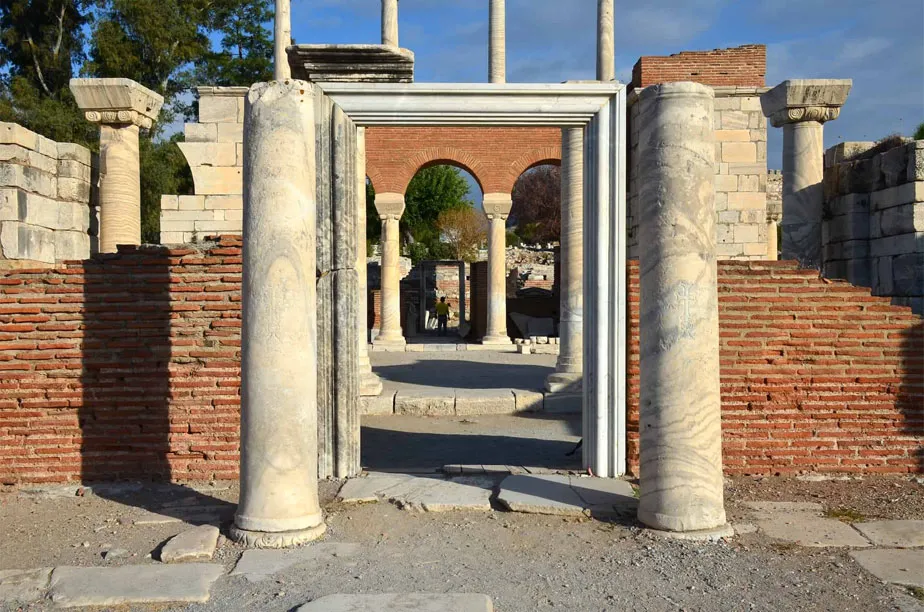
Architectural style: Byzantine architecture
The basilica itself is a masterpiece of Byzantine architecture. Built during the 6th century AD under the orders of the Byzantine Emperor Justinian I, it was designed in the shape of a cross, with a central nave and impressive domes. The interior featured ornate decorations, mosaics, and frescoes that conveyed the grandeur of Byzantine religious art. While the original structure has suffered damage over the centuries, its historical and architectural significance remains undiminished. The basilica was built almost entirely of brick and stones (ashlar), while the columns would have been made of marble or have been marble plated, to withstand the weight of the domes above. The use of timber-roofed towers that were placed over the bay preceding the chancel and the altar had been adopted as well since the course of the 5th century.
St. John’s basilica was cruciform and roofed with six massive domes. The capitals facing the nave (central aisle) bear the monograms of the Emperor Justinian and his wife Theodora.The current entrance leads into the basilica through the southern transept. Originally, entry was through the oversize exterior courtyard atrium to the west of the nave, which led worshipers through the narthex and finally into the far end of the nave.The brick foundations and marble walls have been partially reconstructed; if they were fully restored, the cathedral would be the seventh largest in the world.More recent excavations east of the apse have revealed a baptistery and central pool, along with an attached chapel covered in frescoes depicting the saints.
The monumental basilica was in the shape of a cross and was covered with six domes. Its construction, being of stone and brick, is an extremely rare find amongst the architecture of its time. Raised by two steps and covered with marble, the tomb of St John was under the central dome, that was once carried by the four columns at the corners. The columns in the courtyard reveal the monograms of Emperor Justinian and his wife Theodora. Constructed in the 5th century AD, the baptistery is north of the nave, with its key hole shape. Rampart walls around the church were constructed for protection from the Arabian attacts in the 7th-8th centuries AD. The impressive 10thcentury AD frescoes representing St John, Jesus and a Saint, ornament the chapel. With the invasion of the Turks, the chapel was used as a mosque in the 14th century. Unfortunately the Basilica of Saint John became unusable due to a serious earthquake in the same century.
The excavations around the Basilica of Saint John have been continuing under the supervision of Ekrem Akurgal since 1973, with the financial support of George B. Quatman. This church was built over the tomb of St. John. The presently-visible church is cruciform and roofed with six massive domes, and was donated by the Emperor Justinian and his wife Theodora. The capitals facing the nave (central aisle) bear their monograms.
Exterior
With its resemblance to the Church of the Holy Apostles, the Basilica of St. John also took on the cruciform in its design. The basilica was a domed basilica where the domes were placed over the central crossing, choir, transepts and the nave. Five domes rested on solid piers in the corners of the cross and surmounted the arms and center crossing. To hold such domes in place, massive marble pillars were built and erected to support the domes. Much like the Church of the Holy Apostles, the Basilica of St. John was based on the concept of multiplying the standard element, using short barrel-vaults to expand the square, domed bay into a cross shape. The cupolas of the church would be entirely covered in mosaics as well. Prior to Theodora’s death in 548, Justinian had both her monogram and his placed on the capitals.
The main entrance gate to the basilica was called the “Gate of Persecution” while atrium walls that were built would have surrounded the basilica itself. The walls would have consisted of towers that were either empty or used as bastions. The north side of the church also had a large octagonal baptistery, resembling that of Saint Mary. Near it was a rectangular room with a marble floor and an apse paved with mosaic. An inscription over the door identified it as the secreton where the bishop would have been when he presided as judge. The inscription also shows that it might have been completed during the time Johannes was bishop, who may have been around during the late 6th century.
Interior
The interior of the vault within the church was covered in mosaic while the walls and pillars were covered in marble plates and decorated in different colors. The floors were also covered in mosaics. Numerous parts of the Basilica were of different arrangement, which gave the impression of a large quantity of beautiful enormous oriental carpets covering the entire church “in a fairy-like manner”. Directly beneath the altar lay a crypt with several rooms and of those, the tomb of St. John itself. On the altar itself, the inscription of the 14th verse of the 132nd Psalm can be read, This is my resting place forever, here will I dwell.
The church’s interior would have been covered in frescoes. Hypatius, bishop of Ephesus, was known for advocating the use of icons in the church. After the completion of the church, the interior was covered by icons, representations of saints, and scenes from the Old and New Testaments. Paintings would have included those of Christ raising Lazarus from the dead and Christ crowning Justinian and Theodora. Aside from these, other possible epigrams would have appeared inside the church, one of them being the first book of the Greek Anthology and others being paintings reflecting the origins of the church as an imperial commission.
Architectural Grandeur and Design
The Basilica of St. John was not just a place of worship; it was a marvel of Byzantine architecture. Erected during the reign of the Byzantine Emperor Justinian I, its design and structure were groundbreaking for its time. The basilica was constructed in a distinctive cross form, crowned with six grand domes. These domes were not just architectural feats but also symbolized the heavens above. Massive marble pillars, each intricately carved and bearing the weight of history and artistry, supported these domes. The sheer size and scale of the basilica echoed its importance, not just as a religious site but also as a testament to the architectural prowess of the era.
Inside, the basilica was a spectacle of colors. Mosaics of varying hues adorned the interiors, creating an effect reminiscent of grand oriental carpets. These mosaics depicted scenes from the lives of saints, gospel stories, and other religious narratives, each telling a story of faith and devotion. The large domes, covering areas like the central crossing, choir, transepts, and the nave, were embellished with mosaic tiles, reflecting light and creating an ethereal ambiance. At the heart of the basilica lay its most revered spot – the tomb of St. John. Located beneath the central dome, this sacred site was the focal point of the entire structure. Surrounding the tomb, the basilica’s walls were adorned with frescoes, some dating back to the 10th century AD. These frescoes, preserved through the annals of time, depicted figures like St. John, Jesus, and other saints, each narrating a chapter of the rich Christian history.
The basilica’s exterior was equally impressive. The Persecution Gate, which served as the main entrance, was a testament to the trials and tribulations faced by early Christians. This gate, along with other structures like the Tomb of St. John and a detailed model of the original basilica, offers a glimpse into the grandeur of what was once one of the most sumptuous houses of worship in the world.
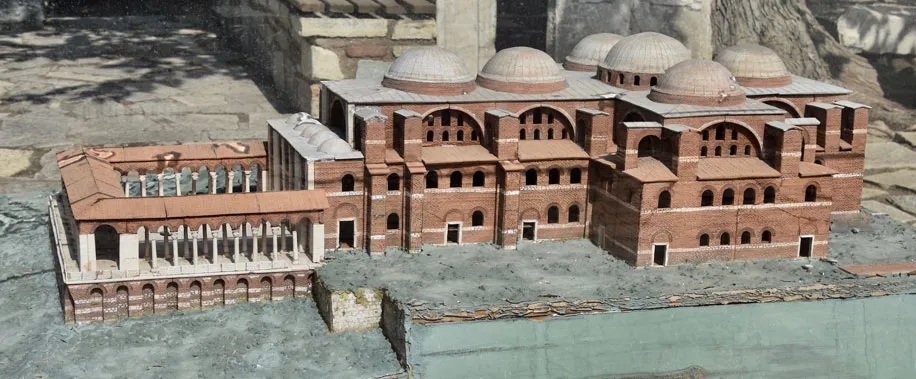
Legends and Miracles
During his time and until his death in Ephesus, St John preached about Christianity. According to legend, before he died, Christ, along with all the other apostles, visited St John and said to him: Come, my beloved one, and join me and all other brethren of thine at my table; the time has finally come to do so,…the Sunday next, thou wilt come to stay henceforth with me.
As the story unfolds, the following Sunday, St. John continued with his preaching of Christianity before finally informing his disciples of his time. Then he entered the cave of his church whereupon an intense light shone, preventing his disciples from entering farther. When the light dissipated, so did St. John. His legend was furthered when the opening of his tomb during Constantine’s reign yielded no body or relics. Another fact that continues to advance the legend of St. John’s assumption into Heaven is the fact that while all the other Saints’ body or relic has been claimed by at least one or more city/church, St. John (along with Mary, the Mother of Jesus) is the only Saint whose body is not claimed by anyone or anywhere.
It was also said that St. John was not dead in, but sleeping beneath his tomb. And each time he breathed, he would cause the dust around his altar to stir, which in turn, made them holy. Because of this, the dust, called manna, was said to be able to cure the sick.
Pilgrimages and Flasks
The stories of St. John and the “manna” continued to grow and even caught the attention of St. Augustine, who could not dismiss them outright. The Anglo-Saxon Willibald, who later became a bishop and a saint, also heard of this and was one of the first many recorded pilgrims to the tomb of St. John. The tomb itself acted upon its miracle every year on 8 May, during an all-night-festal in honor of St. John, for nearly a thousand years, prompting many pilgrimages throughout the medieval period.
The pilgrims who journeyed to Ephesus did not leave empty-handed. Flasks were produced at St. John’s tomb for the pilgrims. These flasks usually had the Saint’s image designed on to it as well. They were used to collect the dusts that would appear around St. John’s tomb, which was then carried back to the pilgrims respective homeland where it was said to have performed miracles by curing sickness and even calm storms on land or sea.
Pope Paul VI Visited the Basilica of St. John
Visitors can also notice a writing saying that Pope Paul VI prayed in this place on July 26th 1967. Having Pope’s arrival to the ruins, made the site a popular one. Today the site have been restored by American foundations like Quatman foundation from Lima, Ohio and Grand Circle Foundation.
The Tomb of St. John (Crypt)
The tomb and the burial area were unearthed by the first excavator, Greek archaeologist G. A. Soteriu, in 1920 – 22. The researcher did not include any information about the tomb, in the first publication. However, in the publication (FiE 4, 1951) prepared by the Austrian Archaeological Institute together with G. A. Soteriu, details were given about the crypt. According to this publication, right under the ciborium in the middle, as ancient authors mentioned, four burials were found. These tombs built with brick and stone roughly formed a cross around a center. The one in the E – W direction located in the middle is larger than the rest which are all in N – S direction. This larger tomb was purported to be the tomb of St. John, the Apostle and the Theologian. The tombs were all empty when excavated.
It is certain that the other tombs were added later on but it is hard to say who were buried in them. This topic has not been researched thoroughly so far, however, the author agrees that the larger tomb in the middle should be the tomb of St. John, as purported above, based on its location. Starting from the Early Christian Period it was believed that the dust taken from this tomb would heal illnesses. THE BASILICA OF ST. JOHN – THE TOMB OF ST. JOHN (CRYPT) Pilgrims usually stopped here on the way to Jerusalem and took some dust with them. Another myth related with St. John is that his tomb rose and lowered as if breathing. This can be interpreted as the populace did not believe St. John had died. These two myths are believed to result in the naming of the city as “Ayasoluk” by Turks. Perhaps the name Ayasoluk means “Holy Breath”.
In the Christian tradition that emerged in the 2nd century, St. John the Theologian of Ephesus is the same person as the Apostle John and as the author of the Fourth Gospel, the Epistles and the Book of Revelation (pillinger 1996, 51; Boyokkolancl 1995a, 192). Pope Paul VI prayed here on July 26, 1967 and since 1990 in the first week of May prayers are held here with the permission granted by the Ministry of Culture.
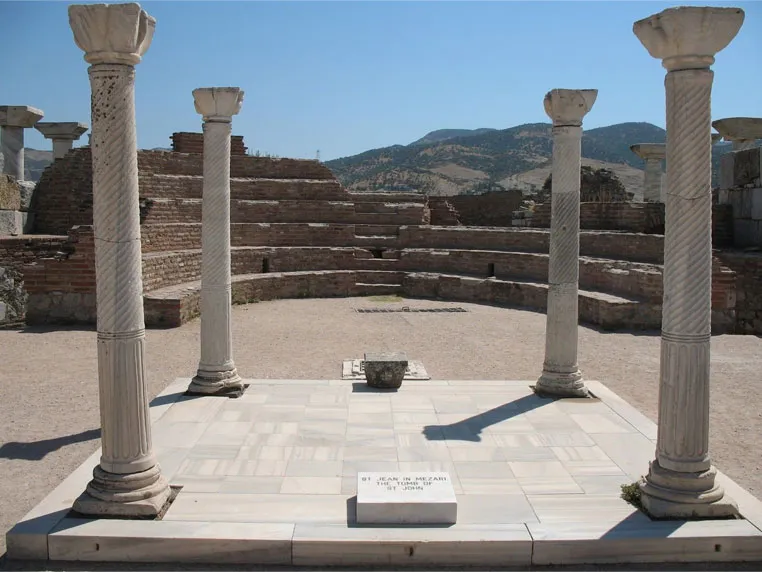
Narthex (VESTIBULE)
Narthex is the hall between the atrium and the main hall of the church. The word ‘narthex’ itself means ‘entrance foyer or vestibule’. Like in the other major churches, there are eight doorways opening into the narthex. The northernmost one and the southernmost one let the people come in from outside. Three in the east open into the main hall. One of these three wide and tall doorways has been restored. To the west three other doorways open into the exonarthex (outer vestibule), which was added later. In the middle part of the narthex are four short semi – columns by the doorways. These semi columns belong to the windows on the upper level and have distinctive cross and vegetal decoration on the capitals.
Nave And Aisles (NAOS)
The Church of St. John is cruciform in plan. The western arm of the cross has a nave and two aisles. The nave in the middle is wider and single storied. The side aisles are narrower and two storied. Following the excavations, the walls were elevated and all the columns of the ground floor and the columns of the north gallery were re-elected.
Baptistery
The baptistery is located to the north of the naos. Between the north aisle and this large building of 734 m2 is a corridor of 3.00 m x 34.00 m. At first glance this corridor looks like a side aisle (as shown in the plan by Hormann) but it ought to be the vestibule of the baptistery. During the construction of the Justinian church this section was covered with a vault. In the late phases of the church tombs were placed here. In the Turkish period the vestibule was used for pressing oil from olives. Relevant mill stones and drainage channels can still be seen. In this vestibule, placed in the south wall of the baptistery is a pretty Byzantine fountain, built of marble blocks. It was uncovered in 1930. The triangular pediment and supporting pillars of this rectangular fountain were procured from a Roman structure in Ephesus. The baptistery is complex consisting of an octagonal central part surrounded by a corridor and corner rooms and flanked with apsidal halls to the east and the west. Having visited the treasury, one enters the eastern apsidal hall through the western doorway of the treasury’s narthex.
Atrium (COURTYARD)
The atrium (courtyard) to the west of the church measures 34.70 m x 47.00 m. Unearthed in 1960 and 1975 by the Ephesus Museum’s team, the atrium has a plan different than its contemporaries. It consists of three sections: the central yard open to the sky, the porticoes, and the walkway for strolling. It rests on a substructure, which was built to make room for the atrium.
Monastery Church (On the Slope to the West of the Atrium)
In 1981, the beginning of a stone paved road was discovered between west gate of the fortifications and the north gate of Isa Bey Mosque. As the work progressed it was understood that this Ottoman road was built over some Byzantine walls and rooms. In 1985 the work on the road was stopped and work on the rooms started. Two adjoining rooms to the north were excavated and the floor paved with big baked clay plates was reached, and a corridor to the west of these rooms, and a three-aisled basilica and other rooms to the south were unearthed. The only find from the excavations to help dating the structure is a coin from the reign of Justinian I (527 – 565), recovered during the cleaning of the nave floor. It shows that the church, and the monastery, might have been built before the reign of Justinian.
St. John’s Journey to Ephesus and Legacy
There were no clear written inscriptions about the travel of St John to Ephesus. However, it is believed that John traveled from Jerusalem to Ephesus, where he remained for the rest of his life after the crucifixion. Numerous evidence confirm John’s residence in Ephesus and from there Emperor Domitian exiled him to the Isle of Patmos for 8 years, where he wrote Revelation (the Apocalypse). In the time of Emperor Nevra, John was pardoned and returned to Ephesus where he lived for the rest of his life. St. John was the youngest of the apostles and He is said to have lived to old age, dying at Ephesus (A.D. 93-94) during the reign of Emperor Trajan. It is believed to be the same person as John the Apostle (John, son of Zebedee), and the Gospel of John. The most important document confirming the residency of St. John in Ephesus is the letter from the Ecumenical Council held in Ephesus (A.D. 431). This letter describes “the city of the Ephesus” as where John the Evangelist and the Virgin Mary lived and were buried.
Exploring the Basilica Today
In the modern era, the Basilica of St. John stands as a bridge between the past and the present, offering visitors a unique blend of history, spirituality, and architectural splendor. While time has taken its toll, the ruins of the basilica still echo the grandeur of its heyday. Today, as travelers tread the grounds of the basilica, they are greeted by the remnants of its once-majestic structure. The massive marble pillars, some of which have been reconstructed, stand as silent witnesses to the basilica’s glorious past. The remains of the grand altar, believed to be the resting place of John the Apostle, beckon with tales of faith and devotion.
One of the standout features for visitors is the Persecution Gate, which once served as the grand entrance to the basilica. This gate, with its intricate carvings and design, offers a glimpse into the basilica’s architectural prowess. Nearby, a detailed model showcases what the original structure might have looked like, providing a visual journey through time. The interiors, though in ruins, still showcase the artistry of the bygone era. Fragments of intricate mosaics and frescoes line the walls, each piece narrating a story from the annals of Christian history. These artworks, preserved through centuries, offer insights into the religious practices and beliefs of the time.
But the experience of the Basilica of St. John isn’t just limited to its historical and architectural aspects. The terrace of the basilica is a must-visit spot, offering breathtaking panoramic views of the surrounding countryside, including the imposing Ayasuluk Citadel. The serene ambiance, coupled with the stunning vistas, makes it a favorite among visitors. For those looking to take a piece of their journey home, the area surrounding the basilica is dotted with kiosks selling hand-crafted souvenirs. From locally made jewelry to postcards capturing the essence of the basilica, there’s something for everyone. And after a day of exploration, visitors can relax at the nearby cafes and restaurants, savoring authentic Turkish cuisine while reminiscing about their journey through time.
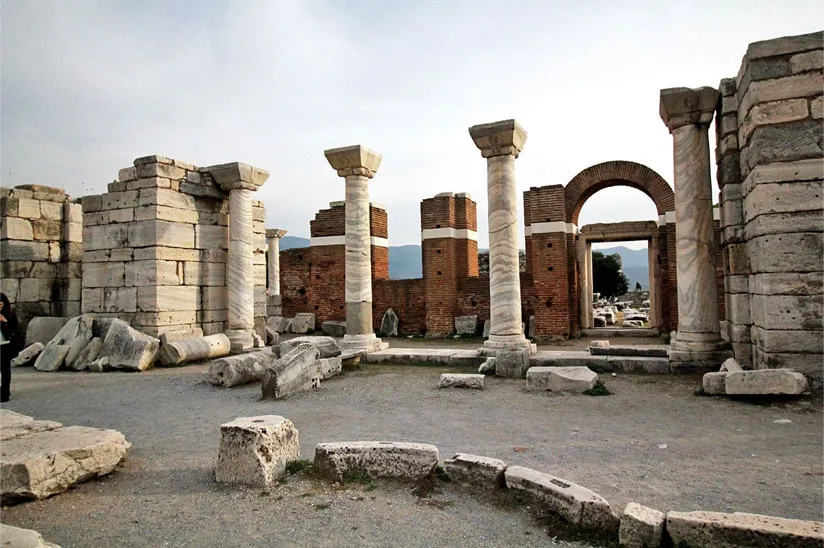
Annual Feast Day
Feast day: December 27th
The Basilica of St. John, located in Selçuk, Turkey, commemorates the life of St. John the Apostle, who is traditionally believed to have lived and been buried there. The feast day of St. John the Apostle is celebrated on December 27th in the Catholic Church and on May 8th in the Orthodox Church. These dates are observed to honor his life, teachings, and contributions to Christianity.
Mass Timing
Opening/Closing Hours
Monday to Saturday: 8.00 a.m. to 6.00 p.m.
Contact Info
Atatürk,
St. Jean Cd.,
35920 Selçuk/İzmir,
Türkiye
Phone No.
Tel : +90 2328926010
Tel :+90 2328926011
Accommodations
Connectivities
Airway
The nearest airport to The Church of Basilica of Saint John Ephesus, Turkey is, Selcuk Efes Airport, Atatürk, 35920 Selçuk/İzmir, Türkiye, which is just 15 min (6.8 km) via Atatürk Cd./D550 away from the basilica.
Railway
The nearest railway to The Church of Basilica of Saint John Ephesus, Turkey, Selcuk Train Station, Zafer, Bozkır Cd. No:2, 35920 Selçuk/İzmir, Türkiye, which is just 5 min (1.2 km) via Bozkır Cd away from the basilica.

